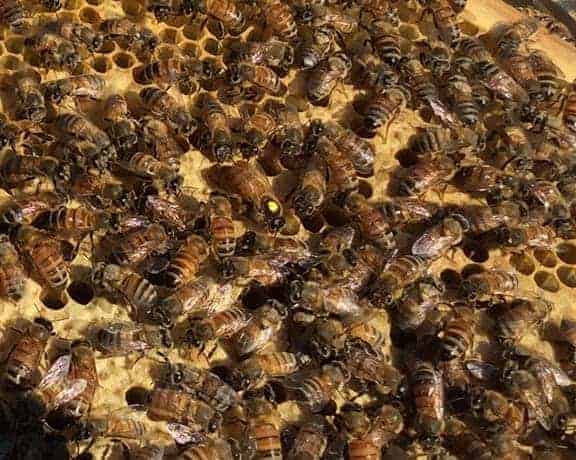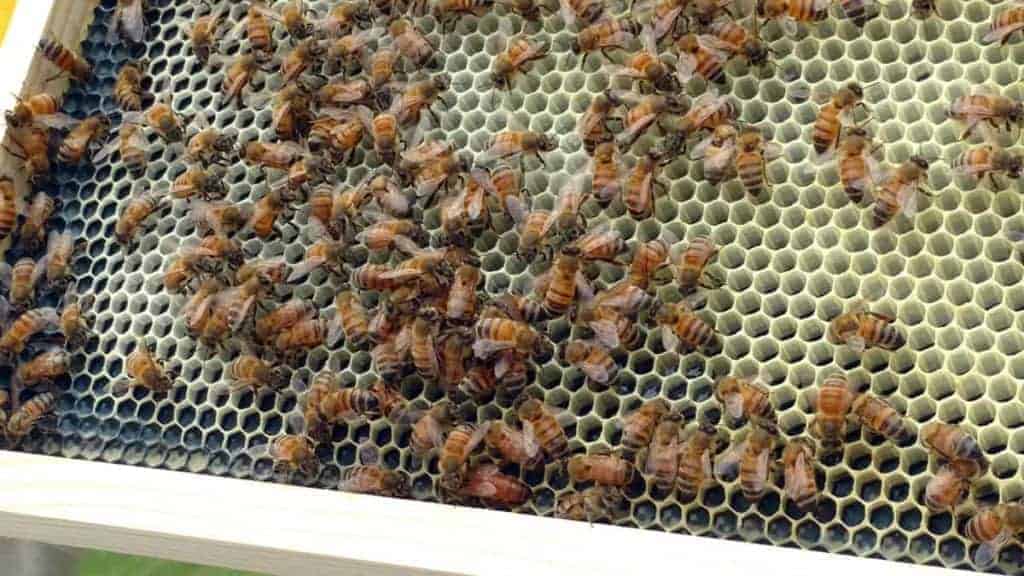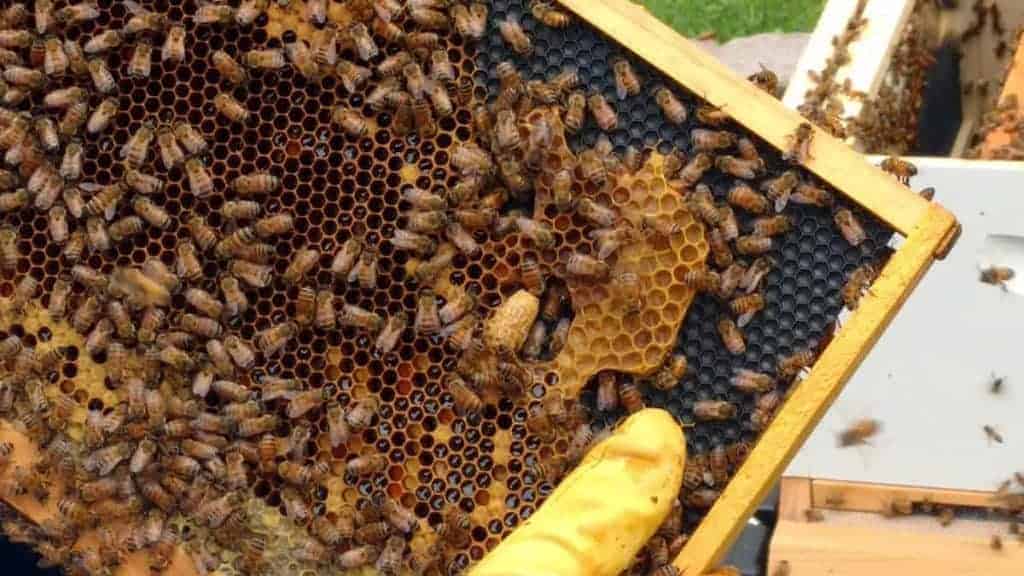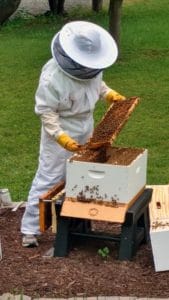Happenings in the Bee Yard
This week I had planned to talk about installing a nuc. But, I didn’t get pictures when I installed my nucs. Since I had to move my original marked queen into a nuc, I am going to use that nuc as the focus of my installing a nuc.
This week I thought I would share some of my “bee musings” from my first six weeks as a beekeeper. But, before I indulge in musings, let’s talk about what happened in the bee yard this week. This week I had an onsite visit with clients in Kalamazoo, Michigan. But, ever on my mind was what the bees were up to in my absence.
The Nuc
The colony in the nucleus hive is really beginning to show some signs of growth. The numbers of foragers have been growing and the colony is making honey and storing pollen.
When foragers began bringing in pollen a couple of weeks ago, the marked queen in this hive – that would be Eleanor after Eleanor of Aquitaine – began to lay again. There are now eggs and larvae appearing to replace the brood that has been hatching out from the transfer of the queen into this nuc.
The colony is slowly building comb, but only slowly at this point. It will likely be a few more weeks before it will be ready for its transfer to a new home.
Currently, the workers have begun drawing comb on the third and fourth frames of the nuc. Eleanor thought she would elude me this week, but I found her on the primary brood frame.
I did note that again it appears I have one laying worker in this colony. as there was one cell with two eggs in it. I will continue monitoring the nuc to see if I can catch the laying worker. This problem will most likely take care of itself given the lifespan of a worker bee during the summer months.
The Weaker Hive
My weaker hive has had an eventful few weeks as they managed to remain queenless despite two capped queen cells. With little capped brood left and no eggs or extremely young larvae to grow a new queen, this colony had a crisis.
Before leaving, I requeened the hive with a Carniolan queen. I left her in her queen cage with hopes that the workers would accept and release her. I gave this colony a second deep last week because they have filled much of what would have been brood space with honey in the absence of a queen.
The colony has started to draw comb on the new frames, but it will be a few weeks before there are enough workers to really begin to draw out comb for additional growth.
After inspecting the frames in the new deep box, I set it aside to take a look at the frames in the original deep box. I installed the queen cage in the center of this box between two frames. I forced myself to methodically work through the frames until I got to the center frames. At first, I thought the queen was still in the cage, but when I pulled it from the wax, I discovered that it was simply a couple of workers inside the cage.
The workers did a beautiful job of completely clearing the candy from the cage and releasing the queen. Working through the rest of the frames, I saw her!
She is a beautiful chocolate brown color and is larger than I expected for a Carniolan queen. And, she has been a busy lady! The colony has its first eggs and larvae in weeks and the aggressive activity of the workers on prior inspections has already evaporated.
The Stronger Hive
This colony just never disappoints. Regicide, extreme growth, you name it, this colony provides it.
Since I installed the new deep box, they have drawn comb nearly complete on 5 of the 10 frames. The new queen has been quite busy laying eggs in much of the new comb in the second deep box and replenishing cells emptied in the lower deep box. This hive is showing every likelihood of needing a medium box added in the next few weeks.
Looking through the frames, it was interesting to find a number of queen cups but all of them were empty. This development will bear watching over the next few weeks to make sure there are no surprises.
I replenished the sugar water since they had drained the top hive feeder dry. Since I added the second deep, this colony has stopped building comb in the opening for the top hive feeder. I guess that additional space was what they wanted.
These bees are beginning to fill in spaces with a lot of propolis. I believe they may be collecting it from the pines in the back yard.
Some Bee Musings
So a few months ago, I began this journey of becoming a beekeeper. I had many conceptions of what it would be like but that was then and this is now. After having become an actual beekeeper with bees happily buzzing around my backyard, I have learned a few things.
Expect the Unexpected
As part of nature, bees are going to act like a living organism and many times they are going to surprise you with behavior that is not what you expected. I expected that I would end up with two colonies (two hives) in my first year as a beekeeper. My bees had totally different intentions.
They decided that two’s nice, but three sounds just right! Bees follow their own intentions when it comes to colony expansion so learn to expect the unexpected and how to react when the unexpected turns up on your hive’s door!
Be Willing to Learn
When you become a beekeeper, I believe you become a steward of one of the most incredible creatures on our planet. And since you are their “owner” (or is it the other way around?!), you have a responsibility to learn about the craft of beekeeping.
Take a beginning beekeeping course, read as many books as you can get your hands on (there are many really solid reference works available), join your local beekeeper’s club, find a bee mentor, and learn, learn, learn.
Share Your Experiences
Your experiences are not part of a vacuum. Rather, your experiences help add to the knowledge base of your fellow beekeepers. Be sure that you take the time to share things you discover about your bees and colonies as you work with your bees.
Your observations might be an important piece in understanding the behaviors of bees or even in providing more mite-resistant bees. If you keep everything you learn to yourself, only you benefit from that knowledge.
Enjoy Yourself
I believe that enjoying yourself in the bee yard is an absolute. I have yet to find a single moment in my bee yard that hasn’t been a real moment of enjoyment.
From my first inspection to the discovery of a new queen, it is a joy to open the hives and see what the bees have decided to do this week. If you truly love beekeeping, you may just find yourself “communing with your bees”.
I have found that just sitting by the hives, listening to the low buzz of the bees and watching them go about their daily business is soothing to me as well as being quite fascinating to watch. If we don’t enjoy this activity, why would we want to do it?
Don’t Be Afraid to Ask Questions
The only dumb question is the one you’re afraid to ask. Remember, we are new beekeepers. New beekeepers don’t know everything nor should we. And if I have learned anything in the past few months, veteran beekeepers are more than willing to share their knowledge and experience with us.
Do Thorough and Regular Inspections
Thorough and regular inspections will keep you from some nasty surprises. My regular hive inspections helped me discover the potential for a swarm when we found two capped queen cups. And a regular inspection helped me discover that both of those queens had emerged and neither one was in the hive.
Inspections are important to keeping our colonies healthy, knowing when to add hive boxes, and knowing when to treat for mites, disease, or go beetle trapping!
Keep Good Records
Keeping good records is an integral part of good beekeeping. Either invest in a journal to record your thoughts, purchase software to track your inspections and other colony information, and/or keep notebooks of your information.
But whatever you do, keep good records. You will find that those records will help track how the colonies are performing over time. And, they will serve as useful benchmarks in the future.
Besides, blogging about my beekeeping experiences, I keep a journal from each hive inspection and also keep records of my hives and hive inspections using Hive Tracks software.
Coming Next Time
Stay tuned for more information about the progress of my hives. Next week, I am going to test my hives for varroa mites and discuss what the test results tell me about the health of my hives. And, since I found two small hive beetles scurrying around in my weaker hive, I’ll be deploying small hive beetle traps.
Until next time, happy beekeeping!




